An SSL certificate plays a critical role in establishing secure communication sessions between a user’s browser and the website’s server they’re connecting to. But what is an SSL certificate exactly, and how does it work to protect your business’s sensitive data?
An SSL certificate (or, more accurately, a TLS certificate) is one of the most crucial components of web security. An SSL certificate allows anyone visiting a website to check whether the website is authentic and whether the data transferred to the website is securely encrypted. This makes it indispensable.
But what is an SSL certificate? How does an SSL certificate work? And why do you need an SSL certificate for your website — moreover, what are the advantages of using one?
What Is an SSL Certificate?
An SSL certificate is a digital certificate that enables users to connect securely to your website. These data files contain information about your organization that allows your site’s server to authenticate to users’ devices and establish encrypted connections.
The term SSL is industry shorthand for “secure sockets layer.” This is a security protocol that enables encrypted communication sessions via public networks. SSL certificates are digital files that companies use to secure their website’s data transmissions and assert their organizational identities. In a basic sense, it’s what makes that friendly “HTTPS” appear in your customers’ browsers and informs them that your site is secure.
(For a more in-depth look at SSL definition and meaning, be sure to check out our other article on the topic.)
However, the truth is that “SSL” and “SSL certificate” are outdated terms that persist in the IT security community. The industry now relies on another secure protocol called transport layer security, or TLS, for this purpose. TLS is, essentially, the successor of SSL. TLS has some technical differences that we won’t go into here, but the point here is that it offers greater speed and security when establishing those secure connections.
So, you’ll come to realize that people within the industry use the terms “SSL” and “TLS” interchangeably all the time. Sometimes, you’ll see them written in a combination method like “SSL/TLS” instead. Either way, we just wanted to take a moment to explain that to provide a little clarity.
What Does an SSL Certificate Do?
To put it simply, SSL/TLS certificates are what make that padlock icon and “HTTPS” appear in users’ web browsers. It looks like this:

TLS certificates basically do the same things as SSL certificates, so people typically use the terms interchangeably. This is why you’ll often see people calling them “SSL/TLS certificates” as a way to incorporate both terms. What SSL/TLS certificates do is:
Assert Your Organizational Identity to Your Website
This is a crucial step. Before a browser can establish a secure connection, it needs to know that you’re trustworthy. This requires your server to authenticate with the browser.
Encrypt Data Transmissions to Keep Data Secure In Transit
These certificates help third parties (such as users’ devices) establish an encrypted connection with your website so they can transmit their data securely. Every legitimate publicly trusted SSL/TLS certificate can be traced or “chained” back to the root certificate that they originated from. This forms what’s known as an “SSL certificate chain” or the “chain of trust” and looks like this:

SSL/TLS certificates are trusted because they’re issued by publicly trusted third parties known as certificate authorities (CAs). CAs are commercial entities that issue various digital certificates to individuals, websites, organizations. But before doing this, they first have to verify that the certificate requestor controls the domain in question (and that the organization itself is legitimate).
SSL/TLS Certificates Come in Multiple Varieties
This part of the blog further answers the question “what is an SSL certificate?” by saying that SSL/TLS certificates aren’t one-size-fits-all tools. They come in multiple varieties to match the needs of your website. These digital certificates are often categorized in one of two ways: 1) by validation type, and 2) by certificate functionality.
SSL Certificate Validation Levels
SSL validation means that a CA verifies ownership of a domain and/or other information about the requesting company before issuing an SSL certificate. Based on the extensiveness of the verification the CA performs, SSL certificates can be categorized into three validation levels:
Domain Validation (DV)
A domain validation certificate is the most basic SSL certificate because it only validates domain ownership. This level of verification is useful for informative websites that don’t collect information from visitors. DV certificates are also typically inexpensive and take only minutes to acquire for your site.
Organization Validation (OV)
An organization validation certificate offers basic business validation for organizations that want verification of their business and not just their website. In addition to verifying domain ownership, the CA will verify the place of business, the registration documents, the telephone number, and even call to confirm the information. OV should be the minimum level used by sites that collect sensitive data from site visitors.
Extended Validation (EV)
If the website collects personal data, including the bank details of the visitors, then an EV certificate is your best option. Because EV stands for “extended validation,” this certificate is issued only after the CA has completed a thorough verification of the enterprise. In general, EV certificates take more time to issue than OV certificates due to their stringent validation processes.
As such, it takes one to five days to verify all the details and issue the EV certificate. However, the lengthy verification process is worth the wait because you’ll be able to prominently display your company’s verified name where it’s easy to find both in your browser and in the certificate’s information itself.
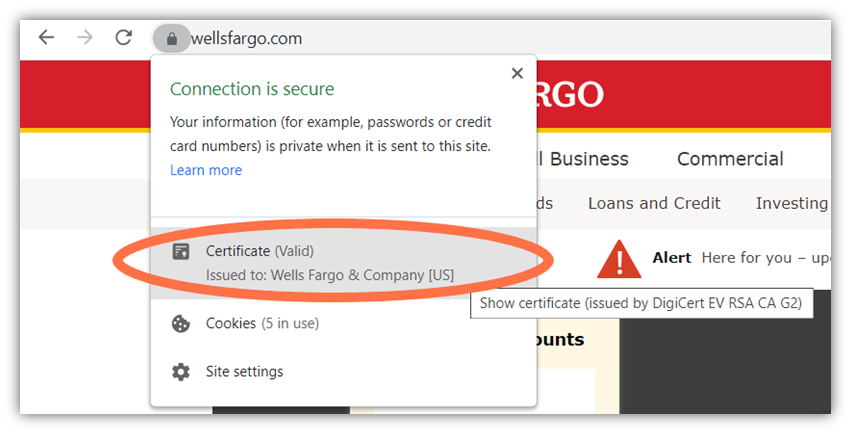
A screenshot of the type of verified company information that displays when you click on the security padlock icon in your browser’s address bar on sites using EV certificates.
If you click on that Certificate (Valid) message, it brings up a separate window that allows you to view the certificate information more in depth. Here, you can find additional verified company information in the certificate’s subject details section (as seen in the screenshot below).
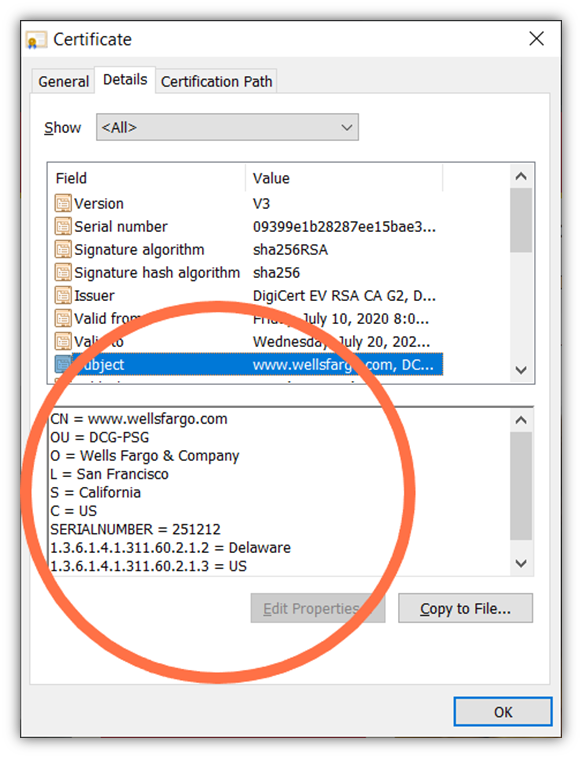
SSL Certificate Functionalities
Every business has different needs. A small company might not have many domains and subdomains to secure, whereas an established and well-known organization might own many domains and subdomains. SSL providers offer different types of certificates to cater to businesses’ needs.
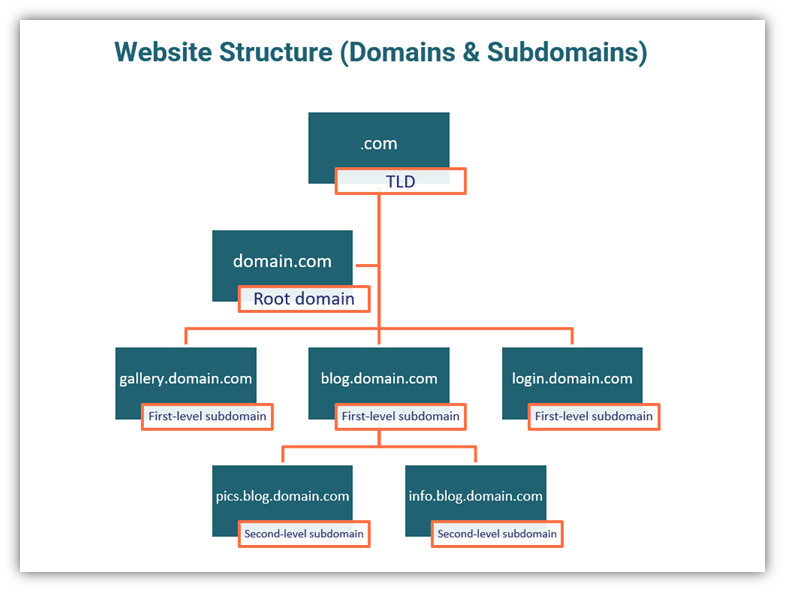
This brings us to our second categorization of SSL certificates: functionalities.
Single domain certificates
Single-domain websites are designed to secure one primary domain (i.e., your root domain). This certificate does not cover subdomains or subject alternative name (SAN) domains, so they’re best if you own just one website. Single domain certificates are inexpensive and offer basic encryption to the website.
For instance, if your website name is mywebsite.com, it will display a padlock in the URL bar like this:
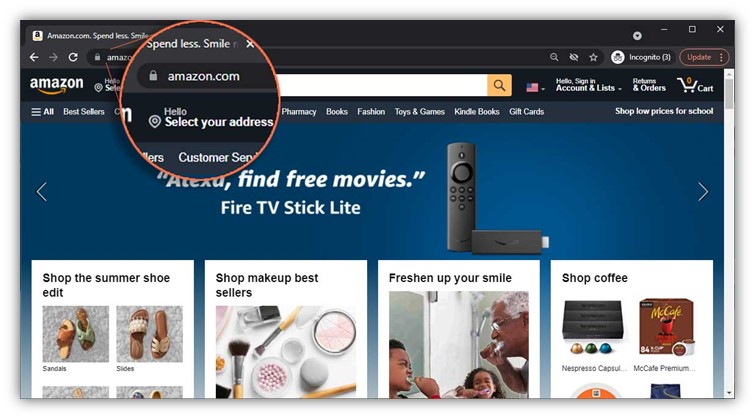
Wildcard Certificate
If you have a single domain with multiple subdomains, you can opt for a wildcard certificate. A wildcard certificate can secure your primary domain and all your single-level subdomains in a single certificate. You don’t have to spend time and energy on managing a bunch of individual certificates for all of those subdomains.
For example, if your domain name is mywebsite.com and you have multiple subdomains on a single level (such as blog.mywebsite.com, store.mywebsite.com, and login.mywebsite.com), then your wildcard certificate will cover all of them.
The figure below is a representation of how this concept looks on a live website using Oracle.com’s subdomains developer.oracle.com, docs.oracle.com, and investor.oracle.com:

Multi-Domain Certificate
A multi-domain certificate secures multiple domains under a single SSL/TLS certificate. This means that you only have to manage one certificate instead of several simultaneously. This makes certificate management a breeze since you don’t have to keep track of multiple certificates, each of which may have different expiration dates. For example, all your domains mywebsite1.com, mywebsite2.com, and mywebsite3.com can be secured with a single multi-domain certificate.
The following figure is a visual representation of how this concept looks on a live website using Amazon’s domains amazon.com, amazon.co.jp, and amazon.co.uk:
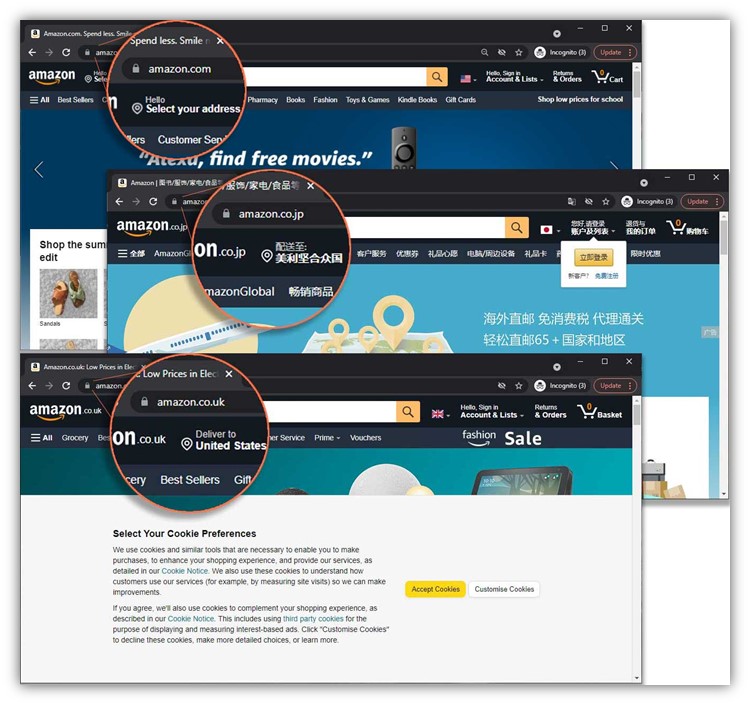
Multi-Domain Wildcard
As the name suggests, the multi-domain wildcard certificate has the capacity to secure multiple domains along with their registered subdomains. So, if you’re a big corporation with multiple websites, each of which has multiple subdomains, then you can buy a single certificate to secure all of them. This makes it easier to buy, manage, and renew the certificate without much effort when the time comes.
Let’s look at an example of how this concept looks using Amazon’s domains amazon.com and amazon.co.uk, and their subdomain pharmacy.amazon.com:

How Does an SSL Certificate Work?
We mentioned earlier that an SSL certificate is a data file that contains identifying information about your organization or website. But that’s not all it does. SSL/TLS certificates provide identifying information and cryptographic specifications. This data enables your server to identify and authenticate itself to your customers’ web clients (browsers) and establish unique secure sessions.
SSL certificates contain many types of public and sensitive information, including:
- Information about the certificate issuer (i.e., the CA that issued the certificate),
- Information about the certificate owner (i.e., the domain and/or organization the certificate was issued to),
- A copy of the certificate’s public key,
- Which encryption and hashing algorithms it supports, and
- Which SSL/TLS protocol versions it supports.
Having this information enables web clients (browsers) and your website’s server to agree upon how they want to communicate securely.
SSL Certificates Help Endpoints Establish Secure Connections
An SSL certificate is a key component of public key infrastructure, aka PKI. In simple words, PKI is a framework of standards, technologies and processes that allow you to manage everything relating to public key encryption. A big part of this is managing the lifecycles of digital certificates — everything from their creation and distributions to their usage, reissuances, and revocations. And at the heart of PKI is public key encryption.
But what is public key encryption and why is it important? The answer is simple yet complex: without public key encryption, there would be no security on the internet. When data transmits across the internet, it does so in plaintext form, meaning that anyone who intercepts it can read it. The only way to protect that information is to use encryption to turn your sensitive plaintext data into gibberish that no one can comprehend without something known as a decryption key.
Public key encryption, or what’s known as asymmetric encryption, is essential to making that happen. over the internet. Asymmetric encryption relies on public key pairs — sets of mathematically similar yet unique cryptographic keys — to encrypt and decrypt data in transit.
- The public key encrypts plaintext data. A public key is easily available to everybody, hence the name. It can’t be used to decrypt data signed by the same key.
- The private key decrypts encrypted data. This key is secret, which means no one but the key holder (i.e., your web server) can decrypt data that’s signed by the public key. Anybody who tries to intercept the data during the transmission will only see indiscernible text. This makes it impossible for them to steal your customers’ sensitive data.
An SSL/TLS certificate is what makes the conversation between these two parties possible. Once they exchange all the necessary information using public key encryption, the server and browser then create asymmetric session key that’s specially designed for that individual session. This key makes it possible to securely transfer data between the website and the client using symmetric encryption, which is faster than public key encryption. The data from both sides will be encrypted and decrypted for the rest of the session using this session key.
The video attached below will give you a graphic description of this process:
Why Do You Need an SSL Certificate?
If you own a website, it is not an option for you to make it a success unless you have an SSL certificate. The reason why you need an SSL certificate for your website is multi-faceted.
SSL Certificates Authenticate Your Identity
A certificate authority (CA) verifies the requestor owns or controls the website. In the case of OV and EV certificates, the CA takes it a step further to verify that the organization itself is legitimate. (OV provides basic business validation, whereas EV provides extensive verification of your company.) OV and EV certificates offer higher trustworthiness so your customers can feel confident doing business with your organization.
An EV certificate is preferable because it builds greater trust because it requires a trusted third party to verify your identity and ensure your organization is in good standing. This level of validation is particularly good for the following types of sites:
- Hospitals and healthcare organizations,
- Ecommerce sites, and
- Banking and other financial institutions.
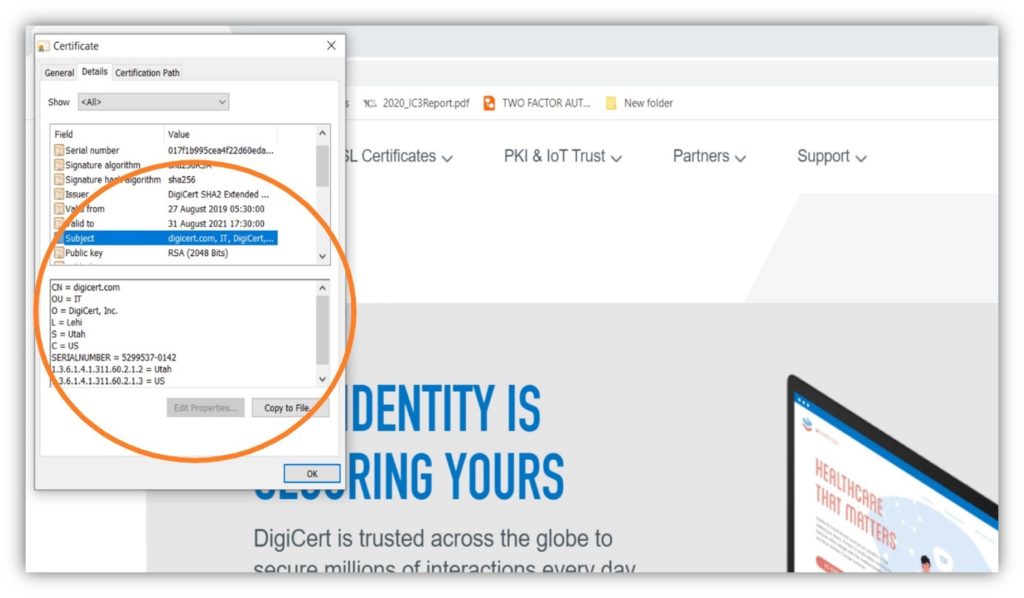
SSL Certificates Enable Secure Communication Sessions
An SSL certificate will ensure that the data transferred between the two devices is secure from malicious interceptors. (These are known as man-in-the-middle attackers.) As we have seen above, the data will be encrypted to make it unreadable to anyone who does not have the necessary decryption key. Hence, you can protect your user IDs, passwords, and other sensitive information as it transmits across the internet.
SSL Certificates Help You Achieve Higher Search Engine Ranking
Virtually all of the major search engines, including Google, consider HTTPS one of the ranking factors for websites. In 2018, Google Chrome started posting ominous “Not Secure” signs on the address bar when a site was not HTTPS. The search engines may block your website if you do not have an SSL certificate in the near future.
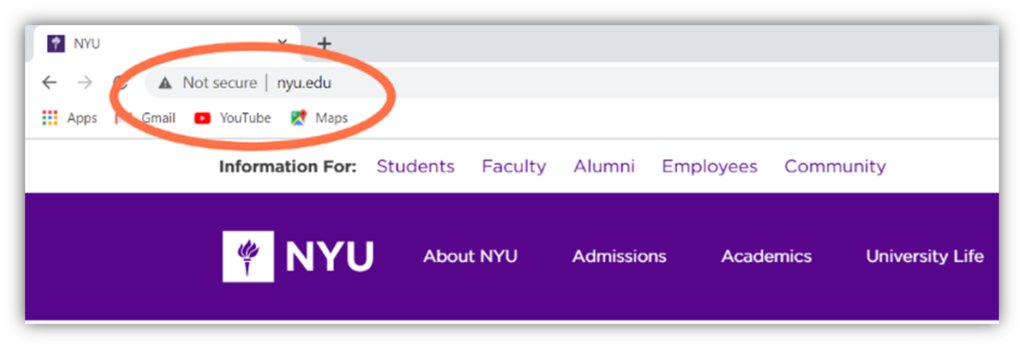
SSL Certificates Are Mandatory If You Want to Accept Payments
This is a particularly important answer to the question, “why do you need an SSL certificate?” The Payment Card Industry Data Security Standards (PCI DSS) is an information security standard for enterprises that accepts credit card payments.
Suppose you have a website to conduct online business where you accept online payments. In that case, you need to familiarize yourself with PCI DSS because it requires you to have an SSL certificate that makes your website secure.
If you don’t have an SSL certificate and accept payments from your customers, then you’ll violate PCI DSS requirements. This means that if you accept payment online via major card brands but don’t have a valid certificate installed on your site, you will face penalties including heavy monthly penalties from individual credit card companies. This could be the end to your online business as you know it.
Your Customers Can Trust You
In the case of online business, your customers cannot trust you without anything concrete to prove your authenticity. If they have a third-party assurance, they will trust you easily and buy stuff from your website without any qualms. An OV or EV SSL certificate is just that: it’s a third-party assurance that your website is genuine and that your business is a going concern. It also assures your customers that their data will be transferred securely from their device to the website’s server. This can have very positive effects on your customer base and their relationship with your online store.
Research from Baymard Institute shows that 17% of customers who abandon their carts do so because they don’t trust the website with their credit card information. If your website has a message that screams “Not Secure” at your customers, it only makes sense that they’ll leave your site and buy their goods elsewhere — likely from one of your competitors. Using a valid SSL certificate is key to building trust with users and their web clients.
How Do I Get an SSL Certificate?
If you have understood the concept and need for an SSL certificate, you probably have one final question in mind: “how do I get it?” Well, here’s your answer…
CheapSSLsecurity.com offers SSL/TLS certificates at some of the lowest prices on the internet. Whether you want a DV, OV or EV certificate, CheapSSLsecurity.com has many options for you to choose from. You can provide the paperwork and other details and get your SSL certificate in no time.
Final Thoughts on “What Is an SSL Certificate & Why Do I Need It?”
Much like how you lock your home to keep away attackers, you need to have the little padlock for your website to keep away bad hackers and other cybercriminals. Having the padlock icon that the SSL certificate gives your site’s web address bar is mandatory in a world where malicious attacks are increasing daily.
In order to have an SSL certificate, you just need to prove your authenticity to your CA. If you don’t like the process or find it too detailed, think again. This process is designed to keep away the phony businesses that can ruin your good name and reputation online. So, there is no need for you to be overwhelmed by the geek terminology and the certification process that’s designed for your own safety.





